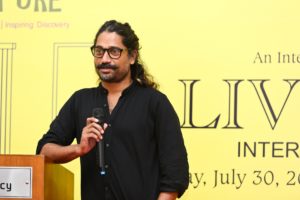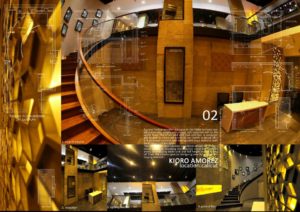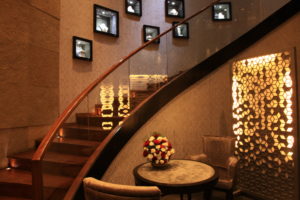
The joy of creating and seeing one’s idea take shape is inexplicable; an emotion Brijesh Shaijal knows too well. For those in the field of architecture, Brijesh needs no introduction. He enjoys an almost rockstar-like status among the young, aspiring architects.
Brijesh is the Principal Architect at DAC (BSArchitect) and one of the founders of the unique World Architecture Travel. In an interview with Cindrebay, the much-loved architect speaks about his passion for everything traditional and explains how an idea cannot exist independent of the contexts within which it germinated.
“I love that architecture gives me the ability to design places that touch the soul. Through my work I realised how intricately architecture is intertwined with every element of our lives; the geography, climate, religion, economics and personal beliefs,” he says.
Brijesh’s creations are the best of both worlds; traditional and modern. “Amalgamation of authentic heritage art forms with existing modern elements in architecture is my vision,” he says. His company, DAC, located in Kerala, caters to a clientele whose interests are inclined both towards traditional Kerala architecture and modern lifestyles.
Ideas are sum of their contexts:

Brijesh’s perception of architecture as sum of its surroundings is a recurring theme both in his works and ideas. He points out that an architectural idea is not independent of its past and present contexts. Advising those dabbling in Contemporary architecture, Brijesh adds, “Contemporary architecture is influenced by many factors. The design process should not only fulfill the designer’s desires but also take into account the surrounding local and global contexts.”
He further adds the contexts of climate, cultural, economic, political, computational and environmental are very important in determining an architectural design.

The architect also has an important advice to those looking to invest in building homes or other structures; stay away from homogenisation. “There are advantages and disadvantages of increasing globalisation of design. There is also an argument to be made that our world is becoming increasingly homogenised. Everyone’s house looks the same! Homes should blend with their natural environment. Traditional Asian architecture can co-exist with contemporary international styles. According to me, these spaces can be made for the benefit of a conscious, self-aware public and society, and furthermore, can be sustainable, well-functioning, user-oriented and beautiful,” he says.
It is towards this principle of building a structure that is both beautiful and at harmony with its surroundings, and is not caught in the mad rush towards urbanization that his firm is inching towards. “Urbanisation, along with the pressure it creates on urban land and services, has a significant bearing on the older/historic areas within cities, often leading to deterioration and decay, as well as the loss of harmony. Unfortunately, this dimension of livability is frequently neglected by policy-makers.”
“This is, of course, not unusual as traditionally, across the developing world, rehabilitation and conservation of historic and inner-city districts receives little attention in urban development policy, with the focus mainly on monuments, or remains of monuments, or at the most, sites or complexes containing a number of monuments or other historic structures. Lack of interest on the part of many owners in maintaining their properties, historic districts in Indian cities increasingly resembles urban slums. Our firm, BSA, is an active member of the Indian Institute of Architects. We regularly advocate causes such as this in seminars and other IIA activities. One of our seminars, Crossroads 2014 was one such event which created a platform for architects to choose different historic areas of the city and give it a new face,” he adds.
Inception of WAT:
Brijesh took his two loves; travel and architecture and created a unique concept called World Architecture Travel (WAT) “I am an avid traveller, and those experiences have been instrumental in grooming my skills and knowledge. I decided to give it a professional platform as currently we don’t have a team in India catering to such a specific concept. WAT reaches out to individuals with a passion for architecture, urban design, and culture,” he explains.
“With WAT, one can travel to places of modern architecture, and unexplored places. A well-planned experience of contemporary architecture through city walks, culture trails and academic discussions are organised with a team of experienced architects, historians, and academicians. WAT is also is supported by the World Architecture Festival (WAF), the annual festival and awards ceremony for the architecture industry dedicated to celebrating and sharing architectural excellence from across the globe.”
Impact of technology:

Sensitive to the changes taking place in the dynamic world of architecture and interior design, Brijesh is quick to acknowledge the way technology is shaping this profession. “Technology is changing architecture. The world of computational design means architects are now pursuing new frontiers where architecture can be generated through the writing of algorithms and software,” he says. He also points out how Indian architectural style is evolving to suit the needs of a new, technologically-aware nation. “Changing lifestyles of contemporary Indian society and the 24/7 work patterns of IT companies make the country a truly global participant that is increasingly demanding innovation of public and private spaces. There is a definite rewriting of Indian architecture,” he adds.
The architect feels that the future of Indian architecture is bright. “We have some really talented young architects to look out for like Ar. Hamid, Ar. Hafeez, Ar. Jack Chandy , Ar. Jills and Soumya, among others.”
Brijesh is disarmingly dismissive about the fanfare that follows him. “My involvement at the grass root level of various organizations has helped me arrange discussions or initiate movements for various issues that we face today. This has led to my participation with the academia. I love teaching and grooming students to be better architects. I believe you should catch aspiring architects young, and watch them grow. I am grateful for their support,” he says.
